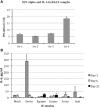Expression Dynamics of Innate Immunity in Influenza Virus-Infected Swine
- PMID: 28484702
- PMCID: PMC5399951
- DOI: 10.3389/fvets.2017.00048
Expression Dynamics of Innate Immunity in Influenza Virus-Infected Swine
Abstract
The current circulating swine influenza virus (IV) subtypes in Europe (H1N1, H1N2, and H3N2) are associated with clinical outbreaks of disease. However, we showed that pigs could be susceptible to other IV strains that are able to cross the species barrier. In this work, we extended our investigations into whether different IV strains able to cross the species barrier might give rise to different innate immune responses that could be associated with pathological lesions. For this purpose, we used the same samples collected in a previous study of ours, in which healthy pigs had been infected with a H3N2 Swine IV and four different H3N8 IV strains circulating in different animal species. Pigs had been clinically inspected and four subjects/group were sacrificed at 3, 6, and 21 days post infection. In the present study, all groups but mock exhibited antibody responses to IV nucleoprotein protein. Pulmonary lesions and high-titered viral replication were observed in pigs infected with the swine-adapted virus. Interestingly, pigs infected with avian and seal H3N8 strains also showed moderate lesions and viral replication, whereas equine and canine IVs did not cause overt pathological signs, and replication was barely detectable. Swine IV infection induced interferon (IFN)-alpha and interleukin-6 responses in bronchoalveolar fluids (BALF) at day 3 post infection, as opposed to the other non-swine-adapted virus strains. However, IFN-alpha responses to the swine-adapted virus were not associated with an increase of the local, constitutive expression of IFN-alpha genes. Remarkably, the Equine strain gave rise to a Serum Amyloid A response in BALF despite little if any replication. Each virus strain could be associated with expression of cytokine genes and/or proteins after infection. These responses were observed well beyond the period of virus replication, suggesting a prolonged homeostatic imbalance of the innate immune system.
Keywords: cytokines; influenza; innate immunity; pig; virus.
Figures







Similar articles
-
Cross-Species Infectivity of H3N8 Influenza Virus in an Experimental Infection in Swine.J Virol. 2015 Nov;89(22):11190-202. doi: 10.1128/JVI.01509-15. Epub 2015 Aug 26. J Virol. 2015. PMID: 26311894 Free PMC article.
-
Pathogenesis and subsequent cross-protection of influenza virus infection in pigs sustained by an H1N2 strain.Zoonoses Public Health. 2010 Jun;57(4):273-80. doi: 10.1111/j.1863-2378.2009.01239.x. Epub 2009 Jun 17. Zoonoses Public Health. 2010. PMID: 19538454
-
Serological profiles after consecutive experimental infections of pigs with European H1N1, H3N2, and H1N2 swine influenza viruses.Viral Immunol. 2006 Summer;19(3):373-82. doi: 10.1089/vim.2006.19.373. Viral Immunol. 2006. PMID: 16987057
-
[Swine influenza virus: evolution mechanism and epidemic characterization--a review].Wei Sheng Wu Xue Bao. 2009 Sep;49(9):1138-45. Wei Sheng Wu Xue Bao. 2009. PMID: 20030049 Review. Chinese.
-
Porcine innate and adaptative immune responses to influenza and coronavirus infections.Ann N Y Acad Sci. 2006 Oct;1081(1):130-6. doi: 10.1196/annals.1373.014. Ann N Y Acad Sci. 2006. PMID: 17135502 Free PMC article. Review.
Cited by
-
Kinetics of single and dual simultaneous infection of pigs with swine influenza A virus and porcine reproductive and respiratory syndrome virus.J Vet Intern Med. 2020 Sep;34(5):1903-1913. doi: 10.1111/jvim.15832. Epub 2020 Jul 3. J Vet Intern Med. 2020. PMID: 32618394 Free PMC article.
-
From Snoot to Tail: A Brief Review of Influenza Virus Infection and Immunity in Pigs.J Immunol. 2023 Oct 15;211(8):1187-1194. doi: 10.4049/jimmunol.2300385. J Immunol. 2023. PMID: 37782856 Free PMC article. Review.
References
LinkOut - more resources
Full Text Sources
Other Literature Sources

